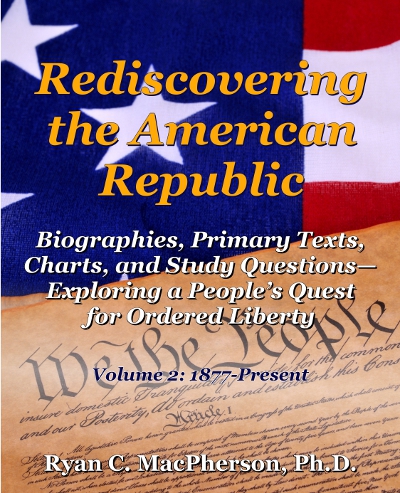Excerpted from: Rediscovering the American Republic, vol. 2: 1877–Present
Jim Crow in Southern Society (ca. 1870–ca. 1900)
In 1870, Americans likely would not have foreseen the need for the civil rights movement of the 1950s and 1960s. In 1870, the Fifteenth Amendment guaranteed African Americans the right to vote. Two years earlier, the Fourteenth Amendment had guaranteed them full rights of citizenship. Three years before that, the Thirteenth Amendment had abolished slavery in America forever. A new era clearly had begun, an era known as Reconstruction. Not only were African Americans permitted to vote in theory, but they were in actuality elected to public office as well. About six hundred were elected to state legislatures, fourteen to the U.S. House of Representatives, and two to the U.S. Senate during the years following the Civil War. But after a few decades, most of this progress in racial equality was erased.
After the last federal troops left the South following the compromise election of Rutherford B. Hayes in 1877, southern whites wrestled control of their states from the influence of black voters. Social customs and legal codes, known as “Jim Crow,” imposed a strict separation of the races throughout society. Blacks could not sit in the same train cars as whites, seek employment in the same jobs as whites, enroll their children in the same schools as whites, live in the same neighborhoods as whites, or be buried in the same cemeteries as whites. Some black men who crossed the color line—particularly in those instances involving communication with a white woman—suffered torture and death at the hands of lynch mobs. Although most black men were never lynched, the mere possibility paralyzed many of them with fear.
If intimidation by groups such as the Ku Klux Klan was not enough to keep blacks from voting, a series of new laws targeted blacks for disqualification. For example, poll taxes prevented poorer blacks from voting, and literacy tests were rigged in such a manner that even well-educated blacks failed to satisfy the white administrators. For all practical purposes, southern blacks had been relegated to second-class citizenship by the early twentieth century, with no one in the federal government willing to enforce the Fourteenth or Fifteenth Amendment.
African American Activism before Brown (early to mid 1900s)
By the 1930s, a new generation of African Americans was poised to make a difference. The cultural innovations of the Harlem Renaissance during the 1920s had given artistic expression to a new black consciousness, dubbed the “New Negro.” Blacks who came of age during the mid century increasingly aspired to something greater than the second-class citizenship they had inherited from Jim Crow. The National Association for the Advancement of Colored People (NAACP), founding in 1909, established a platform for articulating social reform and provided assistance in urban communities.
African Americans also were laying the foundation for a civil rights revolution in the courtroom. Charles H. Houston, a black graduate of Harvard Law School, served as dean of Howard University’s School of Law from 1929 to 1935. Howard, an all-black university located in Washington, DC, produced a number of strong graduates, including Thurgood Marshall (Law School class of 1933), who later served on the U.S. Supreme Court. In 1935, Houston became the legal advisor to the NAACP. Thus began a series of court victories culminating in the landmark school desegregation decision, Brown v. Board of Education (1954).
Brown v. Board of Education (1954)
In 1952, five similar cases came before the U.S. Supreme Court for combined oral argument. The lead case involved Linda Brown, a young school child who had to cross railroad tracks in Topeka, Kansas, to get to an all-black school since the closer, all-white school prohibited her from enrolling. In a second case, twenty black parents in South Carolina sued the local government for not providing adequate funding or staffing to the black schools. The other three cases likewise brought grievances concerning public school segregation, so the Court arranged to consider them together as a group.
Thurgood Marshall, by now an NAACP attorney, represented the black students. He argued not merely that the school districts failed to meet the “separate but equal” standard the Court had established in Plessy v. Ferguson (1896), but furthermore that not even complete equality in funding, staffing, and other tangible factors would guarantee an equal educational opportunity. To prove this last point, Marshall relied upon psychological research by Kenneth and Mamie Clark. The Clarks had interviewed children who were asked to play with black and white dolls. Black children identified themselves with the black dolls, but expressed a strong preference for the white dolls as the “nice” or “good” dolls that they would rather play with. From these reports, the Clarks inferred that even at a young age children internalize the value structure of racial segregation; black children accordingly develop a sense of racial inferiority. Segregated schooling therefore causes psychological harm that hinders classroom learning, which is to say, black students confined to a segregated school do not learn as well as those who are permitted to attend an integrated school.
The Supreme Court agreed. “We conclude that, in the field of public education, the doctrine of ‘separate but equal’ has no place,” wrote the Court in an unanimous opinion, issued in May 1954. “Separate educational facilities are inherently unequal.” The Court further explained that the guarantee of equal citizenship provided by Fourteenth Amendment is broad enough to include a right to education, since education itself is fundamental to democratic citizenship. A subsequent ruling, known as Brown II (1955), called upon local governments to integrate their schools “with all deliberate speed,” but gave those local governments considerable discretion as to how to do so. With no firm deadline being set, many southern school districts dragged their feet. Meanwhile, about one hundred members of Congress signed a Southern Manifesto (1956), decrying the Brown v. Board of Education ruling as an overreach of federal authority. Even President Dwight D. Eisenhower thought the Court had been unwise to force school integration upon the South rather than permit race relations to work themselves out more gradually.
The Murder of Emmett Till (1955)
Emmett Till, a fourteen-year-old black Chicago boy, learned a lesson about Jim Crow that cost him his life while visiting his relatives in Mississippi in August 1955. Emmett bragged to his southern cousin about dating a white girl in the North and then proceeded to say something flirtatious to Carolyn Bryant, a white married woman who worked at a Mississippi grocery store. Her husband Roy and his brother-in-law J.W. Milam kidnapped Emmett from his grandfather’s house. Three days later, a fisherman found the child’s disfigured body in the Tallahatchie River. An all-white jury found both Roy Bryant and J.W. Milam not guilty. With the Fifth Amendment protecting them from being tried for the same crime twice, they sold their story to a Look magazine journalist for $4000, confessing to the boy’s murder.
Despite the injustice, two factors suggested that times were starting to change. First, the trial of Bryant and Milam was the first instance in Mississippi history of a black man—in this case, Emmett’s grandfather—testifying in court against a white man. Second, Emmett’s mother arranged an open-casket funeral and Jet magazine published a gruesome picture of the boy’s remains, drawing the sympathy of northern whites. In the years that followed, similar mixtures of southern black activism and northern white sympathy would fan a flame of civil rights reform that nobody could extinguish.
The Montgomery Bus Boycott (1955–1956)
Although the Brown decision required that public schools be integrated, it did nothing for public transportation. In November 1955, the Interstate Commerce Commission prohibited racially segregated seating on buses and trains crossing state lines, but left local transportation unaffected. On December 1, however, a black woman named Rosa Parks refused to yield her seat to white passengers on a Montgomery, Alabama, bus service. Parks was well liked and well connected in the community, serving as secretary to E.D. Nixon, the president of the local NAACP chapter. Other members of the black community soon rallied around her cause, including college professor Jo Ann Robinson and the Rev. Martin Luther King, Jr. Robinson mimeographed fliers to organize a boycott. King delivered a rousing speech that encouraged the community to extend the boycott. The result was a 381-day boycott involving fifty thousand volunteers. In 1956 the Supreme Court ordered the City of Montgomery to integrate its bus seats. Encouraged by this victory, King and other ministers established the Southern Christian Leadership Conference (SCLC) to organize civil rights projects in other communities as well.
The Little Rock Nine (1957)
When a local school board developed a plan for integrating Central High School of Little Rock, Arkansas, the nation discovered just how divisive race could be in southern communities. Governor Orval Faubus spoke against integration, claiming that the vast majority of the state’s citizens favored segregation and, in any case, the matter should be decided locally, not by federal interference. The NAACP filed a lawsuit urging that the Brown ruling be implemented. The school board sought a compromise to maintain the peace, reducing the number of proposed black pupils from twenty-five to nine. Then the county chancellor ordered a stop to the plan in the name of public safety. The NAACP again took the matter to court, securing a judge’s order to integrate without delay. In response, Governor Faubus deployed the National Guard to prevent the black students from entering the campus.
So who would have the final say? The scene became ripe for disaster. Elizabeth Eckford, one of the nine black school children, was engulfed by an angry white mob of parents and students who shouted racial epithets. A federal judge ordered Faubus to recall the National Guard, but this only left the black school children at the mercy of the white mob. Mayor Woodrow Mann urged President Eisenhower to intervene. Reluctantly, the president agreed. So long as local authorities continued to defy the Supreme Court’s Brown ruling, it was the president’s duty to uphold the rule of law by intervention. Though patient until now, Eisenhower felt forced into acting decisively to ensure the safety of the nine school children and also to defend the constitutional principle that a federal court order trumps the wishes of a state governor. The president federalized the Arkansas National Guard and deployed the 101st Airborne Division to escort the “Little Rock Nine” from their homes to their classrooms at Central High School.
The Sit-In Movements (1960)
In February 1960, four students from North Carolina Agricultural and Technical College, an all-black school located in Greensboro, sat down at the all-white lunch counter in a local Woolworth’s shop to order lunch. They felt emboldened to challenge the color line by their activities in NAACP youth groups and by some presentations they had heard from both Martin Luther King and the Little Rock Nine. Their strategy was to remain calm, polite, and peaceful, asking simply to be treated with respect in return. Their example caught on like wildfire. In the weeks that followed, over ninety percent of their classmates participated in sit-ins—that is, remained seated in the “white” section until served or arrested.
By the year’s end, sit-ins had occurred in 130 cities, spread throughout every southern state except Mississippi. Some 70,000 youth participated, being organized and guided by the Student Nonviolent Coordinating Commission (SNCC, pronounced “snick”). Drawing inspiration from Mahatma Gandhi, SNCC leader James Lawson hosted workshops for coaching college students to remain calm even when attacked by white mobs or brutalized by the police. As presidential candidate John F. Kennedy mused, the sit-ins came out of “the American tradition to stand up for one’s rights—even if the new way is to sit down.”
Continue with Next: The Expansion of the Civil Rights Movement, 1961–1963
- To learn more, purchase:
- See also:


